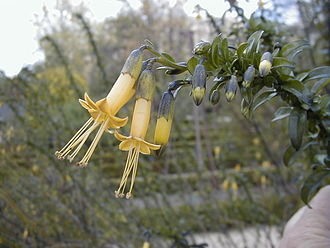Vestia foetida

Vestia is a monotypic genus[2] of flowering plants in the family Solanaceae containing the single species Vestia foetida (syn. V. lycioides). Its principal common names in the Mapudungun language of its native Chile are Huevil (pron. “wayfil” and sometimes redoubled Huevilhuevil) and Chuplín. Other Chilean names include Chuplí, Echuelcún and Palqui (negro) (this last being also applied to Cestrum parqui),[3][4] while an English common name Chilean box thorn has also been coined recently in reference to a certain similarity of the plant to some species in the box thorn / wolfberry genus Lycium (as referenced also in the former specific name lycioides, meaning “Lycium-like”). Vestia foetida is endemic to central and southern Chile, being found in an area stretching from the Valparaíso Region in the north to Chiloé Island (in the Los Lagos Region) in the south.[5] Growing to 2 m (7 ft) tall by 1.5 m (5 ft) broad, it is an evergreen shrub with glossy, privet-like, mid-green leaves. In spring and summer it bears tubular yellow flowers to 3 cm (1 in) long, with stamens so markedly exserted (= protruding) as to recall those of certain Fuchsia species, followed by 4-valved, ovoid capsules to 1 cm (0 in), containing small, prismatic seeds.[6]
The specific epithet foetida refers to the unpleasant smell of this plant.[7]
The genus Vestia was named in honour of Austrian botanist and physician Lorenz Chrysanth von Vest (1776 – 1840) in 1809 by German botanist and pharmacist Carl Ludwig Willdenow (1765 – 1812). Vestia foetida was described by Johann Centurius Hoffmannsegg, the description being published in his Verzeichniss der Pflanzenkulturen in den Grafl. Hoffmannseggischen Garten zu Dresden und Rammenau… [translation: “Directory of plants cultivated in the Dresden and Rammenau gardens of Count Hoffmannsegg”]: 119 (pub. Dresden 1824).[8]
A yellow dye has been extracted from the leaves and stems, and infusions of the plant have been used in the folk medicine of Chile (with due recognition of the toxicity of the medication) to treat dysentery and appendicitis.[4]
Austrian priest and ethnologist, Martin Gusinde (1886-1969), an expert on the ethnomedicine of Chile, records the following concerning medicinal use of Vestia by the Mapuche and Huilliche:
Huevil: Vestia lycioides…it is used for [medicinal] baths. It is an efficacious remedy for chavalongo and dysentery and also for contagious diseases. The natives today use only the term ifɘlkoñ.[9]
[Note: The term chavalongo designates a Chilean disease concept which, in the past, could encompass not only typhoid and typhus but a variety of life-threatening diseases (mostly fevers) having in common their introduction to Chile by Europeans – see page Chavalongo on Wikipédia España].
